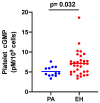Platelet Cyclic GMP Levels Are Reduced in Patients with Primary Aldosteronism
- PMID: 38002693
- PMCID: PMC10672647
- DOI: 10.3390/jcm12227081
Platelet Cyclic GMP Levels Are Reduced in Patients with Primary Aldosteronism
Abstract
Background and aim: Nitric oxide inhibits platelet aggregation by increasing the second messenger cyclic guanosine-3',5'-monophosphate (cGMP) through the activation of soluble guanylyl cyclase in target cells. Within this context, the oxidative stress associated with the aldosterone excess impairs the nitric oxide availability. Thus, the aim of the present study was to assess the impact of chronic aldosterone excess on the platelet nitric oxide/cGMP pathway in humans.
Methods: The levels of cGMP were evaluated in platelets of male patients, 12 with primary aldosteronism (PA) and 32 with uncomplicated essential hypertension (EH), matched for age and blood pressure (BP) values.
Results: PA and EH patients were 52.8 ± 3 years old and 51.6 ± 1.6 years old, respectively. Systolic and diastolic BP were 158 ± 5.0 mmHg and 105.9 ± 2.3 mmHg in PA and did not differ compared to EH patients (156.6 ± 2.4 mmHg and 104.7 ± 1.2 mmHg). Mean aldosterone levels were significantly higher in PA (25.5 ± 8.8 ng/dL) compared toEH (8.11 ± 0.73 ng/dL), whereas potassium was significantly lower in PA (3.52 ± 0.18 mEq/L) compared to EH (4.08 ± 0.04 mEq/L). Aldosterone and potassium were inversely related (r = -0.49, p = 0.0006) in the whole study population (n = 44). Platelet cGMP was significantly lower in PA (5.1 ± 0.36 pM/109 cells) than in EH (7.1 ± 0.53 pM/109 cells), and in the entire study cohort, it was directly related to plasma potassium (r = 0.43, p = 0.0321).
Conclusions: These results show an impairment of nitric oxide/cGMP signaling in platelets of PA patients. This effect is likely related to the potassium-depleting effect of chronic aldosterone excess. Future studies are needed to understand whether the platelet nitric oxide/cGMP system is involved in the atherothrombotic events in these patients.
Keywords: cyclic guanosine-3′,5′-monophosphate; essential hypertension; nitric oxide; primary aldosteronism.
Conflict of interest statement
The authors declare no conflict of interest.
Figures




Similar articles
-
Characterization of the L-arginine-NO-cGMP pathway in spontaneously hypertensive rat platelets: the effects of pregnancy.Hypertens Res. 2010 Sep;33(9):899-904. doi: 10.1038/hr.2010.102. Epub 2010 Jun 17. Hypertens Res. 2010. PMID: 20555333
-
Nitric oxide-sensitive guanylyl cyclase is the only nitric oxide receptor mediating platelet inhibition.J Thromb Haemost. 2010 Jun;8(6):1343-52. doi: 10.1111/j.1538-7836.2010.03806.x. Epub 2010 Feb 11. J Thromb Haemost. 2010. PMID: 20149081
-
N-acetyl-L-cysteine exerts direct anti-aggregating effect on human platelets.Eur J Clin Invest. 2001 May;31(5):452-61. doi: 10.1046/j.1365-2362.2001.00815.x. Eur J Clin Invest. 2001. PMID: 11380598
-
The NO/cGMP/PKG pathway in platelets: The therapeutic potential of PDE5 inhibitors in platelet disorders.J Thromb Haemost. 2022 Nov;20(11):2465-2474. doi: 10.1111/jth.15844. Epub 2022 Aug 21. J Thromb Haemost. 2022. PMID: 35950928 Free PMC article. Review.
-
Conventional and Unconventional Mechanisms for Soluble Guanylyl Cyclase Signaling.J Cardiovasc Pharmacol. 2016 May;67(5):367-72. doi: 10.1097/FJC.0000000000000330. J Cardiovasc Pharmacol. 2016. PMID: 26452163 Review.
References
-
- Alexander Y., Osto E., Schmidt-Trucksass A., Shechter M., Trifunovic D., Duncker D.J., Aboyans V., Back M., Badimon L., Cosentino F., et al. Endothelial function in cardiovascular medicine: A consensus paper of the European Society of Cardiology Working Groups on Atherosclerosis and Vascular Biology, Aorta and Peripheral Vascular Diseases, Coronary Pathophysiology and Microcirculation, and Thrombosis. Cardiovasc. Res. 2021;117:29–42. doi: 10.1093/cvr/cvaa085. - DOI - PMC - PubMed
-
- Nagata D., Takahashi M., Sawai K., Tagami T., Usui T., Shimatsu A., Hirata Y., Naruse M. Molecular mechanism of the inhibitory effect of aldosterone on endothelial NO synthase activity. Hypertension. 2006;48:165–171. doi: 10.1161/01.HYP.0000226054.53527.bb. - DOI - PubMed
LinkOut - more resources
Full Text Sources

